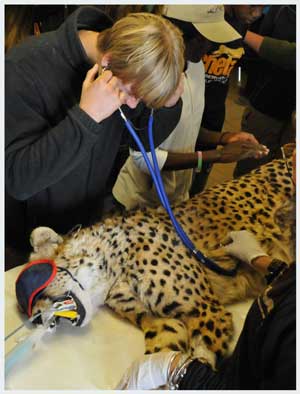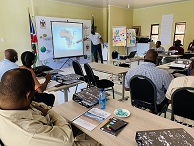
Cheetah Conservation Fund hosts National Geographic students expedition

An important aspect of CCF’s work is census and genetic studies utilising scat-detection dogs. CCF’s Research Assistant Stephanie and scat-detection dog Finn demonstrate the process of finding cheetah scat to members of the National Geographic Student Expedition.
From 14 to 16 July, 23 youth between the ages of 16 and 18 learned from CCF field researchers aspects of cheetah husbandry and veterinary care, ecological.Research, and integrated predator-livestock management techniques, including predator identification and CCF’s famous Livestock Guarding Dog programme. Participants shadowed CCF’s experts in tasks including feeding CCF’s resident cheetahs, looking after livestock and livestock guarding dogs, and using scat-detection dogs to collect cheetah faeces for genetic analysis.
“The National Geographic Student Expeditions are so important, as they give youth a first-hand look at the importance of balanced eco-systems, and introduce them to the various aspects of field conservation and what better place than Namibia, which harbours such a precious array of natural treasures,” said Dr. Laurie Marker, CCF’s Founder and Executive Director. “We are excited to think that the experiences of these young men and women, and especially their visit with us, will encourage them to eventually become the conservation leaders of tomorrow.”
Prior to their arrival at CCF, the group learned about rhino conservation in Damaraland and track leopards at N/a’an Ku Sê, which is also supported by the BCI. The students also visited other Namibian landmarks including the Etosha National Park, and the Namib Desert. Participants in National Geographic Student Expeditions utilise photography, film and other media to develop a special presentation that conveys the messages about conservation issues they encountered during the expedition.












































